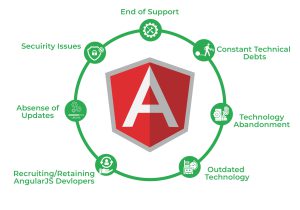Angular: Powering Modern Web Development
In the ever-evolving landscape of web development, Angular stands as a powerhouse among front-end frameworks. Born out of Google’s development efforts, Angular has transformed the way developers build web applications. In this comprehensive guide, we’ll delve into the world of Angular, exploring its core principles, key features, benefits, and real-world applications.
Understanding Angular
Angular, often referred to as “Angular 2+” or simply “Angular,” is a popular open-source front-end web framework developed and maintained by Google and a community of individual developers and corporations. It’s designed for building dynamic, single-page web applications (SPAs) and offers a structured approach to web development.
 Key Components of Angular
Key Components of Angular
- Components: At the heart of Angular are components, which are the building blocks of web applications. Components encapsulate templates, data, and logic, making it easier to manage complex user interfaces.
- Templates: Angular uses HTML templates with Angular-specific syntax to define the user interface of an application. Templates are combined with component logic to render dynamic views.
- Directives: Directives are instructions in the DOM (Document Object Model) that tell Angular how to transform the HTML elements. They extend HTML with new behavior or attributes.
- Services: Services are classes that provide functionality that can be shared across components. They handle tasks such as data retrieval, business logic, and communication with servers.
- Dependency Injection: Angular’s dependency injection system allows you to declare the dependencies your components and services need. It simplifies the management of dependencies and promotes code modularity.
Benefits of Angular
- Modularity: Angular promotes the creation of modular applications, making it easier to develop, test, and maintain different parts of your web app.
- Reusability: Components and services can be reused across your application, reducing code duplication and making development more efficient.
- Two-Way Data Binding: Angular’s two-way data binding ensures that changes in the UI automatically update the underlying data model and vice versa, reducing boilerplate code.
- TypeScript: Angular is built with TypeScript, a statically-typed superset of JavaScript. TypeScript helps catch errors during development and improves code quality.
- Robust Testing: Angular’s design encourages writing testable code. It provides tools like TestBed and Jasmine for unit and integration testing.
Real-World Applications
Angular has found widespread use in a variety of real-world applications:
- Single-Page Applications (SPAs): Angular is a natural choice for building SPAs, where the entire application runs in the browser, offering a seamless user experience.
- E-Commerce: Many e-commerce platforms and online marketplaces rely on Angular for their front-end, allowing for dynamic product catalogs and responsive user interfaces.
- Enterprise Solutions: Large corporations often employ Angular to develop complex internal systems, including project management tools, CRM (Customer Relationship Management) software, and data dashboards.
- Content Management Systems (CMS): Angular powers the front-end of numerous content management systems, enabling content creators to manage and publish web content efficiently.
- Social Media Applications: Social networking platforms and community-driven websites leverage Angular to deliver real-time updates and engaging user experiences.
Getting Started with Angular
If you’re eager to explore Angular, here are some steps to help you get started:
- Install Node.js: Angular requires Node.js and npm (Node Package Manager). Download and install them from the official website.
- Install Angular CLI: The Angular CLI (Command Line Interface) is a powerful tool for generating, building, and deploying Angular applications. Install it globally using npm.
- Create a New Angular Project: Use the Angular CLI to create a new project. You can do this with a single command, specifying the project name.
- Learn TypeScript: Familiarize yourself with TypeScript, as it’s an integral part of Angular development. You can find TypeScript tutorials online.
- Explore Angular Documentation: The official Angular documentation is a valuable resource. Start with the “Tour of Heroes” tutorial to learn the basics.
- Build Small Projects: Practice by building small Angular applications. Start with simple components and gradually add complexity.
- Join the Angular Community: Engage with the Angular community on forums, social media, and developer communities. Learning from experienced developers can be invaluable.
Conclusion
Angular has revolutionized web development by providing a powerful and structured framework for building dynamic web applications. Its modular architecture, two-way data binding, and support for TypeScript make it a favorite among developers for creating modern, maintainable, and scalable applications. Whether you’re building a personal project, launching a startup, or working on enterprise-level applications, Angular equips you with the tools and capabilities needed to succeed in the ever-competitive world of web development. So, dive into Angular, explore its possibilities, and embark on a journey to craft innovative web applications with confidence.

